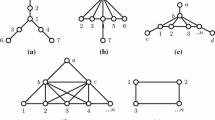Abstract
In this paper we present an exact algorithm for the Maximum Common Induced Subgraph Problem (MCIS) by addressing it directly, using Integer Programming (IP) and polyhedral combinatorics. We study the MCIS polytope and introduce strong valid inequalities, some of which we prove to define facets. Besides, we show an equivalence between our IP model for MCIS and a well-known formulation for the Maximum Clique problem. We report on computational results of branch-and-bound (B&B) and branch-and-cut (B&C) algorithms we implemented and compare them to those yielded by an existing combinatorial algorithm.





Similar content being viewed by others
References
Borndörfer, R. (1997). Aspects of set packing, partitioning, and covering. Ph.D. thesis, Mathematics Department, Technischen Universität, Berlin.
Chen, L., & Robien, W. (1994). Application of the maximal common substructure algorithm to automatic interpretation of 13C NMR spectra. Journal of Chemical Information and Computer Sciences, 34, 934–941.
Conte, D., Guidobaldi, C., & Sansone, C. (2003). A comparison of three maximum common subgraph algorithms on a large database of labeled graphs. In Lecture notes in computer science (Vol. 2726, pp. 130–141). Berlin: Springer.
Edmonds, M. (1975). Private communication (4.2.2; a1.4)
Falkenhainer, B., Forbus, K., & Gentner, D. (1989/1990). The structure-mapping engine: algorithms and examples. Artificial Intelligence, 34, 1–63.
Foggia, P., Sansone, C., & Vento, M. (2001a). A database of graphs for isomorphism and sub-graph isomorphism benchmarking. In CoRR (pp. 176–187).
Foggia, P., Sansone, C., & Vento, M. (2001b). The graph database cd. Available online (consulted at July 2011), http://amalfi.dis.unina.it/graph.
Garey, M. R., & Johnson, D. S. (1979). Computer and intractability: a guide to the theory of NP-completeness. San Francisco: Freeman.
Gifford, E., Johnson, M., Smith, D., & Tsai, C. (1996). Structure-reactivity maps as a tool for visualizing xenobiotic structure-reactivity. Network Science, 2, 1–33.
Horaud, R., & Skordas, T. (1989). Stereo correspondence through feature grouping and maximal cliques. IEEE Transactions on Pattern Analysis and Machine Intelligence, 11, 1168–1180.
Johnson, D. (2002). A theoretician’s guide to the experimental analysis of algorithms. In M. H. Goldwasser, D. S. Johnson, & C. C. McGeoch (Eds.), Data structures, near neighbor searches, and methodology: fifth and sixth DIMACS implementation challenges (pp. 215–250). Providence: Am. Math. Soc.
Kann, V. (1992). On the approximability of the maximum common subgraph problem. In Lecture notes in computer science (Vol. 577, pp. 377–388). Berlin: Springer.
Krissinel, E. B., & Henrick, K. (2004). Common subgraph isomorphism detection by backtracking search. Software, Practice & Experience, 34(6), 591–607. http://dx.doi.org/10.1002/spe.588.
Löebel, A. Porta: Polyhedron representation transformation algorithm. Available online (consulted at September 2010). http://www.iwr.uni-heidelberg.de/groups/comopt/software/PORTA/.
Manić, G. (2007). Modelagem matemática e aplicações de problemas de otimização relativos à busca de subgrafos com estruturas comuns. fapesp’s First Scientific Report, post-doctoral grant # 2006/01817-7 (in Portuguese, unpublished).
Mcgregor, J. J. (1982). Backtrack search algorithms and the maximal common subgraph problem. Software, Practice & Experience, 12(1), 23–34.
Messmer, B. T., & Bunke, H. (1999). Decision tree approach to graph and subgraph isomorphism detection. Pattern Recognition, 32(12), 1979–1998.
Nemhauser, G., & Wolsey, L. (1988). Integer and combinatorial optimization. New York: Wiley.
Nemhauser, G. L., & Sigismondi, G. (1992). A strong cutting plane/branch-and-bound algorithm for node packing. The Journal of the Operational Research Society, 43(5), 443–457. http://www.jstor.org/stable/2583564.
Östergård, P. R. J. (2002). A fast algorithm for the maximum clique problem. Discrete Applied Mathematics, 120, 197–207.
Pelillo, M., Siddiqi, K., & Zucker, S. W. (1999). Matching hierarchical structures using association graphs. IEEE Transactions on Pattern Analysis and Machine Intelligence, 21, 1105–1120.
Piva, B. (2009). Estudo poliedral do problema do máximo subgrafo induzido comum. Master’s thesis, Instituto de Computação, Universidade Estadual de Campinas, Campinas. http://cutter.unicamp.br/document/?down=000477497 (in Portuguese).
Piva, B., & de Souza, C. (2011). Facets for the maximum common induced subgraph problem polytope. Available online (consulted at September 2011). http://www.optimization-online.org/DB_HTML/2011/09/3148.html
Raymond, J. W., & Willett, P. (2002). Maximum common subgraph isomorphism algorithms for the matching of chemical structures. Journal of Computer-Aided Molecular Design, 16(7), 521–533.
Raymond, J. W., Gardiner, E. J., & Willett, P. (2002a). Heuristics for similarity searching of chemical graphs using a maximum common edge subgraph algorithm. Journal of Chemical Information and Computer Sciences, 42(2), 305–316.
Raymond, J. W., Gardiner, E. J., & Willett, P. (2002b). RASCAL: Calculation of graph similarity using maximum common edge subgraphs. The Computer Journal, 45(6), 631–644.
Shearer, K., Bunke, H., & Venkatesh, S. (2001). Video indexing and similarity retrieval by largest common subgraph detection using decision trees. Pattern Recognition, 34, 1075–1091.
Suters, W. H., Abu-Khzam, F. N., Zhang, Y., Symons, C. T., Samatova, N. F., & Langston, M. A. (2005). A new approach and faster exact methods for the maximum common subgraph problem. In Lecture notes in computer science: Vol. 3595. Computing and combinatorics (pp. 717–727). Berlin: Springer.
Wang, Y., & Maple, C. (2005). A novel efficient algorithm for determining maximum common subgraphs. In International conference on information visualisation (IV’05) (pp. 657–663). London: IEEE Comput. Soc. http://doi.ieeecomputersociety.org/10.1109/IV.2005.11.
West, D., et al. (2001). Introduction to graph theory. New York: Prentice Hall.
Willet, P. (1999). Matching of chemical and biological structures using subgraph and maximal common subgraph isomorphism algorithms. The IMA Volumes in Mathematics and Its Applications, 108, 11–38.
Wong, A. K. C., & Akinniyi, F. A. (1983). An algorithm for the largest common subgraph isomorphism using the implicit net. In Inst. electrical & electronics engineers: Vol. 1. Proc. int. conf. systems, man and cybernetics (pp. 197–201).
Author information
Authors and Affiliations
Corresponding author
Additional information
Financial support by Fapesp, grant number 2007/53617-4 (10/2007-02/2009) and CNPq, grants number 132034/2007-7 (03/2007-09/2007), 301732/2007-8 and 472504/2007-0.
Rights and permissions
About this article
Cite this article
Piva, B., de Souza, C.C. Polyhedral study of the maximum common induced subgraph problem. Ann Oper Res 199, 77–102 (2012). https://doi.org/10.1007/s10479-011-1019-8
Published:
Issue Date:
DOI: https://doi.org/10.1007/s10479-011-1019-8




